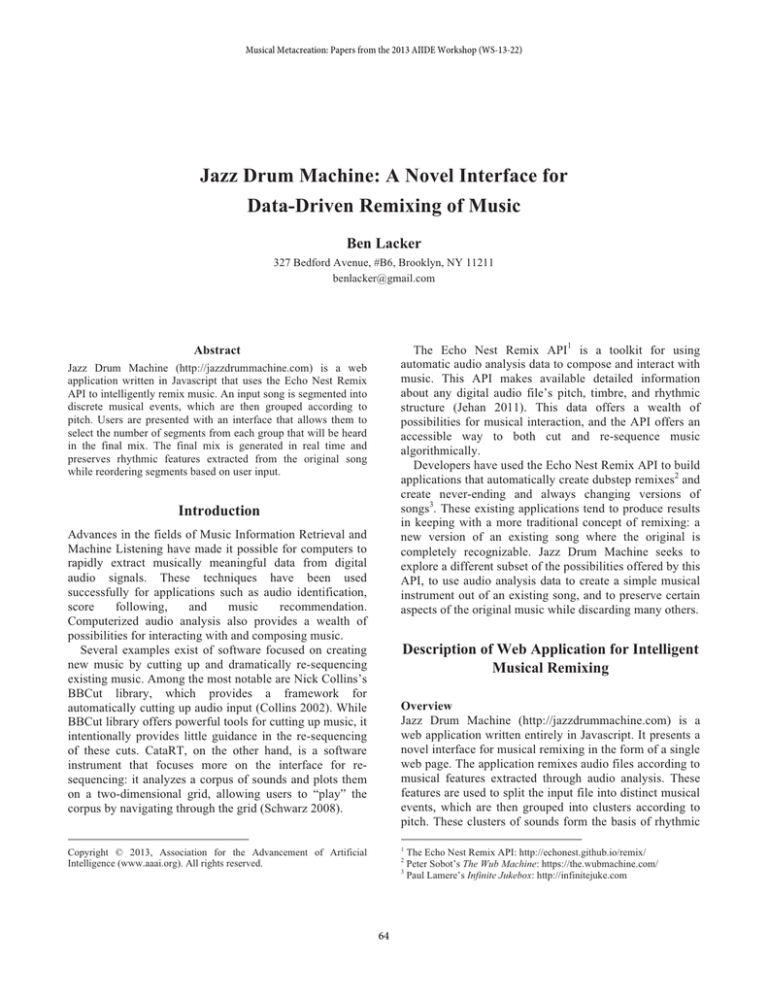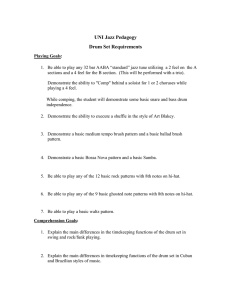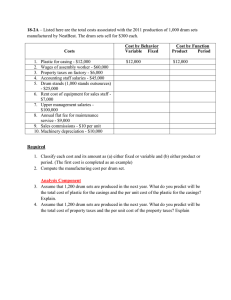
Musical Metacreation: Papers from the 2013 AIIDE Workshop (WS-13-22)
Jazz Drum Machine: A Novel Interface for
Data-Driven Remixing of Music
Ben Lacker
327 Bedford Avenue, #B6, Brooklyn, NY 11211
benlacker@gmail.com
The Echo Nest Remix API1 is a toolkit for using
automatic audio analysis data to compose and interact with
music. This API makes available detailed information
about any digital audio file’s pitch, timbre, and rhythmic
structure (Jehan 2011). This data offers a wealth of
possibilities for musical interaction, and the API offers an
accessible way to both cut and re-sequence music
algorithmically.
Developers have used the Echo Nest Remix API to build
applications that automatically create dubstep remixes2 and
create never-ending and always changing versions of
songs3. These existing applications tend to produce results
in keeping with a more traditional concept of remixing: a
new version of an existing song where the original is
completely recognizable. Jazz Drum Machine seeks to
explore a different subset of the possibilities offered by this
API, to use audio analysis data to create a simple musical
instrument out of an existing song, and to preserve certain
aspects of the original music while discarding many others.
Abstract
Jazz Drum Machine (http://jazzdrummachine.com) is a web
application written in Javascript that uses the Echo Nest Remix
API to intelligently remix music. An input song is segmented into
discrete musical events, which are then grouped according to
pitch. Users are presented with an interface that allows them to
select the number of segments from each group that will be heard
in the final mix. The final mix is generated in real time and
preserves rhythmic features extracted from the original song
while reordering segments based on user input.
Introduction
Advances in the fields of Music Information Retrieval and
Machine Listening have made it possible for computers to
rapidly extract musically meaningful data from digital
audio signals. These techniques have been used
successfully for applications such as audio identification,
score
following,
and
music
recommendation.
Computerized audio analysis also provides a wealth of
possibilities for interacting with and composing music.
Several examples exist of software focused on creating
new music by cutting up and dramatically re-sequencing
existing music. Among the most notable are Nick Collins’s
BBCut library, which provides a framework for
automatically cutting up audio input (Collins 2002). While
BBCut library offers powerful tools for cutting up music, it
intentionally provides little guidance in the re-sequencing
of these cuts. CataRT, on the other hand, is a software
instrument that focuses more on the interface for resequencing: it analyzes a corpus of sounds and plots them
on a two-dimensional grid, allowing users to “play” the
corpus by navigating through the grid (Schwarz 2008).
Description of Web Application for Intelligent
Musical Remixing
Overview
Jazz Drum Machine (http://jazzdrummachine.com) is a
web application written entirely in Javascript. It presents a
novel interface for musical remixing in the form of a single
web page. The application remixes audio files according to
musical features extracted through audio analysis. These
features are used to split the input file into distinct musical
events, which are then grouped into clusters according to
pitch. These clusters of sounds form the basis of rhythmic
1
Copyright © 2013, Association for the Advancement of Artificial
Intelligence (www.aaai.org). All rights reserved.
The Echo Nest Remix API: http://echonest.github.io/remix/
Peter Sobot’s The Wub Machine: https://the.wubmachine.com/
3
Paul Lamere’s Infinite Jukebox: http://infinitejuke.com
2
64
loops, where the user can control how many sounds from
each cluster are present during playback. The onset times
for playback of musical events are derived from the
original audio file, while the decision of which events to
play back is controlled by the user. Thus Jazz Drum
Machine provides an interface for exploring existing audio
recordings, manipulating their playback to reveal subtleties
in the existing material and to create new music.
into clusters corresponding to pitch classes: the tonic note,
the dominant note, etc.
This simple approach to clustering is sufficient for this
application. The goal of Jazz Drum Machine is not to
classify a song’s sounds into precise, intelligible groups. It
is enough that the segments in each group are audibly
similar, as well as audibly different from the segments in
the other groups. Fuzziness about the real-world meaning
of the clusters does not detract from the artistic purposes of
the application.
Audio Analysis
Jazz Drum Machine takes as input a single digital audio
file. While non-musical audio may be used and may
produce interesting effects, the application was designed to
manipulate musical audio, with a particular focus on
rhythmic characteristics. Users can upload an audio file of
their choice for remixing, or use one of several example
songs provided. The example songs, which are recordings
of solos by famous jazz drummers, were chosen to
highlight the application’s tendency to bring a song’s
rhythmic peculiarities to the foreground.
Once an input file has been selected, it is analyzed using
The Echo Nest’s Audio Analysis API4. This API provides
automatic description of the musical features of an audio
file, including tempo, key, pitch, timbre, and detailed
rhythmic information. The rhythmic features include the
onset times of every section, bar, beat, and segment in a
song. As defined by the Echo Nest, a segment is the
smallest possible musical subdivision of a beat, and is
relatively uniform in terms of timbre and harmony. Each
segment is characterized by its pitch, timbre, loudness, and
duration.
User Interface
The user interface consists of a Play button, a Stop button,
and eight sliders. Each slider corresponds to a single
cluster of segments, and the slider’s value determines how
many segments from that cluster will be heard during
playback. Raising a slider halfway will cause half of the
segments from the corresponding cluster to be heard during
playback; raising it just a little bit will cause only the first
segment in the cluster to be heard; raising it all the way
will cause all the segments in that cluster to be heard
during playback. The order in which segments are chosen
from a cluster is based on the segments’ distance from the
center of the cluster. The first segment chosen for playback
from a cluster will be the most central, or the most
representative of its cluster, in terms of pitch content. As
the slider is raised further, the segments selected include
ones further and further from the center of the cluster.
The simplicity of the interface is intentional; it is
designed to be accessible to people with no musical
background. The design also encourages users to approach
the application like a found musical instrument or toy: to
understand it by playing with it.
Clustering of Audio Segments
The audio features provided by the Echo Nest API are used
first to split the input file into distinct musical events. For
example, when a recording of a drum solo is analyzed,
each successive attack will be described as an audio
segment with a distinct pitch and timbre. If the performer
hits a floor tom, that segment’s pitch will reflect the tuning
of the drum; if she then hits a cymbal, a kick drum, and
snare drum a the same time, that segment will be
considerably more noisy, and the pitch descriptor will
reflect that.
Once the input file has been split into musical segments,
these segments are then divided into eight groups based on
their pitch content. A k-means clustering algorithm is used
to place segments into clusters based on similarities in
pitch. This algorithm causes harmonically similar sounds
to end up in the same group. To use again the example of a
jazz drum solo, this approach yields clusters of segments
that loosely correspond to the elements of a drum kit: snare
drum hits, low tom hits, kick drum hits, kick drum and
cymbal hits together, rim shots. A more traditionally
melodic song, such as a solo flute recording, would be split
4
Playback
When the user clicks the Play button, Jazz Drum Machine
begins playing a loop whose length corresponds to one bar
of the input song. This loop will contain all the segments
selected for playback by the user’s manipulation of sliders.
Each segment is played back according to its relative
position within the bar in the original song. In other words,
a segment’s start time within the playback loop is
determined by taking the segment’s start time in the
original song and subtracting the start time of the bar that
contains it. This is perhaps the most important aspect of
Jazz Drum Machine: the preservation of the input song’s
rhythmic information, even while the order of its segments
is changed.
The Echo Nest API: http://developer.echonest.com/
65
original ordering of segments while maintaining the
rhythmic feeling of the original song. Because segments
are played back according to their original times within the
measure, Jazz Drum Machine preserves the rhythmic
idiosyncrasies of its input: techno music sounds just as
quantized, reggae music maintains its slight swing, and
jazz drum solos bear the rhythmic imprints of the soloists.
Conclusions
This simple interface has proven to be remarkably
expressive, teasing interesting nuances out of familiar
music. It highlights the way certain pitches and types of
sounds tend to occur at certain beats within the measure.
The rhythmic “feel” of an input song is brought to the
foreground, while the original structure, melody, and
harmonic progression are obliterated. Jazz Drum Machine
offers a way for musicians and non-musicians alike to
explore existing sounds and to use them as raw material for
creating new music. The author sees this application as an
early step in the work of using the wealth of data offered
by automatic musical analysis for creative purposes.
Figure 1. User Interface of Jazz Drum Machine
References
For example, if a particular segment originally occurred
on the second beat of a measure, it will be heard on the
second beat of the playback loop. If another segment
originally occurred slightly before the third beat of a
different measure, it will be heard just before beat three in
the playback loop. This is where the jazz drum solos
chosen as example tracks prove especially illuminating:
drum solos illustrate the tendency of sound clusters based
on pitch to exhibit different rhythmic properties. Because
the segment clusters derived from drum solos tend to
correspond loosely to different elements of a drum kit,
each cluster tends to maintain the rhythmic characteristics
of that element of the kit. For instance, in jazz and pop
music the snare drum is frequently played on the second
and fourth beats of a measure. If a user raises the slider of
the cluster associated with snare drum sounds, the
segments will mostly be played back on beats two and four
of the playback loop.
Segments from every bar of the original song are
superimposed onto the one-bar playback loop. If every
slider is raised to its maximum height, every segment from
the original song will be heard in the playback loop. This
tends to sound cacophonous, but illustrates the workings of
Jazz Drum Machine: every bar from the original input song
is superimposed onto a one-bar loop, and by controlling the
eight sliders the user can choose which types of sounds
will be heard in the playback loop.
By manipulating the sliders in real time, the user can
create a great variety of loops, all consisting of sounds
from the original song. These loops completely discard the
Collins, N. 2002b. The BBCut Library. In Proceedings of the
International Computer Music Conference, 313-316. Goteborg,
Sweden.
Jehan, T., and DesRoches, D. 2011. Analyzer Documentation.
The Echo Nest. Somerville, MA.
Schwarz, D.; Cahen, R.; and Britton, S. 2008. Principles and
Applications of Interactive Corpus-Based Concatenative
Synthesis. In Journées d’Informatique Musicale (JIM), Albi,
France:
GMEA.
[Online].
Available:
http://articles.ircam.fr/textes/Schwarz08a/
66




